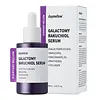What's inside
What's inside
 Key Ingredients
Key Ingredients

 Benefits
Benefits

 Concerns
Concerns

 Ingredients Side-by-side
Ingredients Side-by-side

Galactomyces Ferment Filtrate 95%
HumectantNiacinamide
SmoothingBakuchiol
AntimicrobialPanthenol
Skin ConditioningCollagen
Moisturising1,2-Hexanediol
Skin ConditioningHydroxyacetophenone
AntioxidantSimmondsia Chinensis Seed Oil
EmollientTocopheryl Acetate
AntioxidantPropanediol
SolventButylene Glycol
HumectantCentella Asiatica Extract
CleansingCarbomer
Emulsion StabilisingAlgin
MaskingCeramide NP
Skin ConditioningCannabis Sativa Seed Extract
EmollientAdenosine
Skin ConditioningGeranium Maculatum Oil
MaskingGalactomyces Ferment Filtrate 95%, Niacinamide, Bakuchiol, Panthenol, Collagen, 1,2-Hexanediol, Hydroxyacetophenone, Simmondsia Chinensis Seed Oil, Tocopheryl Acetate, Propanediol, Butylene Glycol, Centella Asiatica Extract, Carbomer, Algin, Ceramide NP, Cannabis Sativa Seed Extract, Adenosine, Geranium Maculatum Oil
Water
Skin ConditioningCentella Asiatica Extract
CleansingButyrospermum Parkii Butter
Skin ConditioningPropanediol
SolventButoxyethanol
MaskingGlycerin
HumectantSimmondsia Chinensis Butter
Skin Conditioning1,2-Hexanediol
Skin ConditioningVitis Vinifera
MaskingCetearyl Glucoside
EmulsifyingCamellia Sinensis Extract
AntioxidantCeramide NP
Skin ConditioningSodium Hyaluronate
HumectantPanthenol
Skin ConditioningAsiatic Acid
Skin ConditioningMadecassic Acid
Skin ConditioningMadecassoside
AntioxidantAllantoin
Skin ConditioningTocopherol
AntioxidantLavandula Angustifolia Oil
MaskingOryza Sativa
Helianthus Annuus Seedcake
AbrasiveMelia Azadirachta Extract
Skin ConditioningCoccinia Indica Fruit Extract
Skin ConditioningCurcuma Longa Rhizome Extract
Skin ConditioningAloe Barbadensis Sprout
HumectantSolanum Melongena Fruit Extract
Skin ConditioningOcimum Sanctum Leaf Extract
Skin ConditioningDipotassium Glycyrrhizate
HumectantAnhydroxylitol
HumectantXylitylglucoside
HumectantSclerotium Gum
Emulsion StabilisingXanthan Gum
EmulsifyingGlucose
HumectantAsiaticoside
AntioxidantCyanocobalamin
Skin ConditioningHydrolyzed Corallina Officinalis
Skin ConditioningEthylhexylglycerin
Skin ConditioningXylitol
HumectantLimonene
PerfumingLinalool
PerfumingGeraniol
PerfumingWater, Centella Asiatica Extract, Butyrospermum Parkii Butter, Propanediol, Butoxyethanol, Glycerin, Simmondsia Chinensis Butter, 1,2-Hexanediol, Vitis Vinifera, Cetearyl Glucoside, Camellia Sinensis Extract, Ceramide NP, Sodium Hyaluronate, Panthenol, Asiatic Acid, Madecassic Acid, Madecassoside, Allantoin, Tocopherol, Lavandula Angustifolia Oil, Oryza Sativa, Helianthus Annuus Seedcake, Melia Azadirachta Extract, Coccinia Indica Fruit Extract, Curcuma Longa Rhizome Extract, Aloe Barbadensis Sprout, Solanum Melongena Fruit Extract, Ocimum Sanctum Leaf Extract, Dipotassium Glycyrrhizate, Anhydroxylitol, Xylitylglucoside, Sclerotium Gum, Xanthan Gum, Glucose, Asiaticoside, Cyanocobalamin, Hydrolyzed Corallina Officinalis, Ethylhexylglycerin, Xylitol, Limonene, Linalool, Geraniol
Ingredients Explained
These ingredients are found in both products.
Ingredients higher up in an ingredient list are typically present in a larger amount.
1,2-Hexanediol is a synthetic liquid and another multi-functional powerhouse.
It is a:
- Humectant, drawing moisture into the skin
- Emollient, helping to soften skin
- Solvent, dispersing and stabilizing formulas
- Preservative booster, enhancing the antimicrobial activity of other preservatives
Centella Asiatica Extract (Centella) is derived from an herb native to Southeast Asia. It is famous for its anti-inflammatory and soothing properties.
Centella is rich in antioxidants and amino acids, such as Madecassic Acid and Asiaticoside.
Studies show the compounds in centella help with:
The combination of all these properties makes centella effective at soothing, hydrating, and protecting the skin.
Other great components of centella include Vitamin A, vitamin C, several B vitamins, and Asiatic Acid.
Fun fact: Centella has been used as a medicine and in food for many centuries. As a medicine, it is used to treat burns, scratches, and wounds.
Learn more about Centella Asiatica ExtractCeramide NP is a type of ceramide.
Ceramides are intercellular lipids naturally found in our skin that bonds dead skin cells together to create a barrier. They are known for their ability to hold water and thus are a great ingredient for dry skin.
Ceramides are an important building block for our skin barrier. A stronger barrier helps the skin look more firm and hydrated. By bolstering the skin ceramides act as a barrier against irritating ingredients. This can help with inflammation as well.
If you would like to eat ceramides, sweet potatoes contain a small amount.
Read more about other common types of ceramides here:
Ceramide AP
Ceramide EOP
Panthenol is a common ingredient that helps hydrate and soothe the skin. It is found naturally in our skin and hair.
There are two forms of panthenol: D and L.
D-panthenol is also known as dexpanthenol. Most cosmetics use dexpanthenol or a mixture of D and L-panthenol.
Panthenol is famous due to its ability to go deeper into the skin's layers. Using this ingredient has numerous pros (and no cons):
Like hyaluronic acid, panthenol is a humectant. Humectants are able to bind and hold large amounts of water to keep skin hydrated.
This ingredient works well for wound healing. It works by increasing tissue in the wound and helps close open wounds.
Once oxidized, panthenol converts to pantothenic acid. Panthothenic acid is found in all living cells.
This ingredient is also referred to as pro-vitamin B5.
Learn more about PanthenolPropanediol is an all-star ingredient. It softens, hydrates, and smooths the skin.
It’s often used to:
Propanediol is not likely to cause sensitivity and considered safe to use. It is derived from corn or petroleum with a clear color and no scent.
Learn more about Propanediol